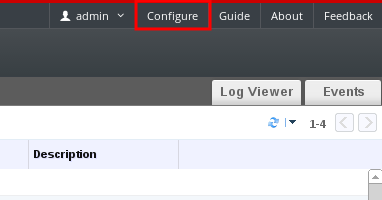Este contenido no está disponible en el idioma seleccionado.
14.7. Administering User Tasks From the Administration Portal
14.7.1. Adding Users and Assigning User Portal Permissions
Copiar enlaceEnlace copiado en el portapapeles!
Users must be created already before they can be added and assigned roles and permissions. The roles and permissions assigned in this procedure give the user the permission to log in to the User Portal and to start creating virtual machines. The procedure also applies to group accounts.
Procedure 14.7. Adding Users and Assigning User Portal Permissions
- On the header bar, click Configure to open the Configure window. Click System Permissions.
- Click to open the Add System Permission to User window.
- Select a profile under Search. The profile is the domain you want to search. Enter a name or part of a name in the search text field, and click . Alternatively, click to view a list of all users and groups.
- Select the check boxes for the appropriate users or groups.
- Select an appropriate role to assign under Role to Assign. The role gives the user account the permission to log in to the User Portal.
- Click .
Log in to the User Portal to verify that the user account has the permissions to log in.
14.7.2. Viewing User Information
Copiar enlaceEnlace copiado en el portapapeles!
You can view detailed information about each user in the Users tab.
Procedure 14.8. Viewing User Information
- Click the Users tab to display the list of authorized users.
- Select the user, or perform a search if the user is not visible on the results list.
- The details pane displays for the selected user, usually with the General tab displaying general information, such as the domain name, email and status of the user.
- The other tabs allow you to view groups, permissions, quotas, and events for the user.For example, to view the groups to which the user belongs, click the Directory Groups tab.
14.7.3. Viewing User Permissions on Resources
Copiar enlaceEnlace copiado en el portapapeles!
Users can be assigned permissions on specific resources or a hierarchy of resources. You can view the assigned users and their permissions on each resource.
Procedure 14.9. Viewing User Permissions on Resources
- Click the resource tabs, and select a resource in the results list.
- Click the Permissions tab of the details pane to list the assigned users, the user's role, and the inherited permissions for the selected resource.
14.7.4. Removing Users
Copiar enlaceEnlace copiado en el portapapeles!
When a user account is no longer required, remove it from Red Hat Enterprise Virtualization.
Procedure 14.10. Removing Users
- Click the Users tab to display the list of authorized users.
- Select the user to be removed. Ensure the user is not running any virtual machines.
- Click the button. A message displays prompting you to confirm the removal. Click .
The user is removed from Red Hat Enterprise Virtualization, but not from the external directory.
14.7.5. Viewing Logged In Users
Copiar enlaceEnlace copiado en el portapapeles!
In Red Hat Enterprise Virtualization 3.6 and later you can view the users who are currently logged in. Click the Guest Information entry in the tree pane to view the details of the session for each logged in user.
14.7.6. Terminating a User Session
Copiar enlaceEnlace copiado en el portapapeles!
In Red Hat Enterprise Virtualization 3.6 and later you can terminate the session of a user who is currently logged in.
Procedure 14.11. Terminating a User Session
- Click the Guest Information entry in the tree pane.
- Select the user session to be terminated.
- Click Terminate Session.
- Click OK.
